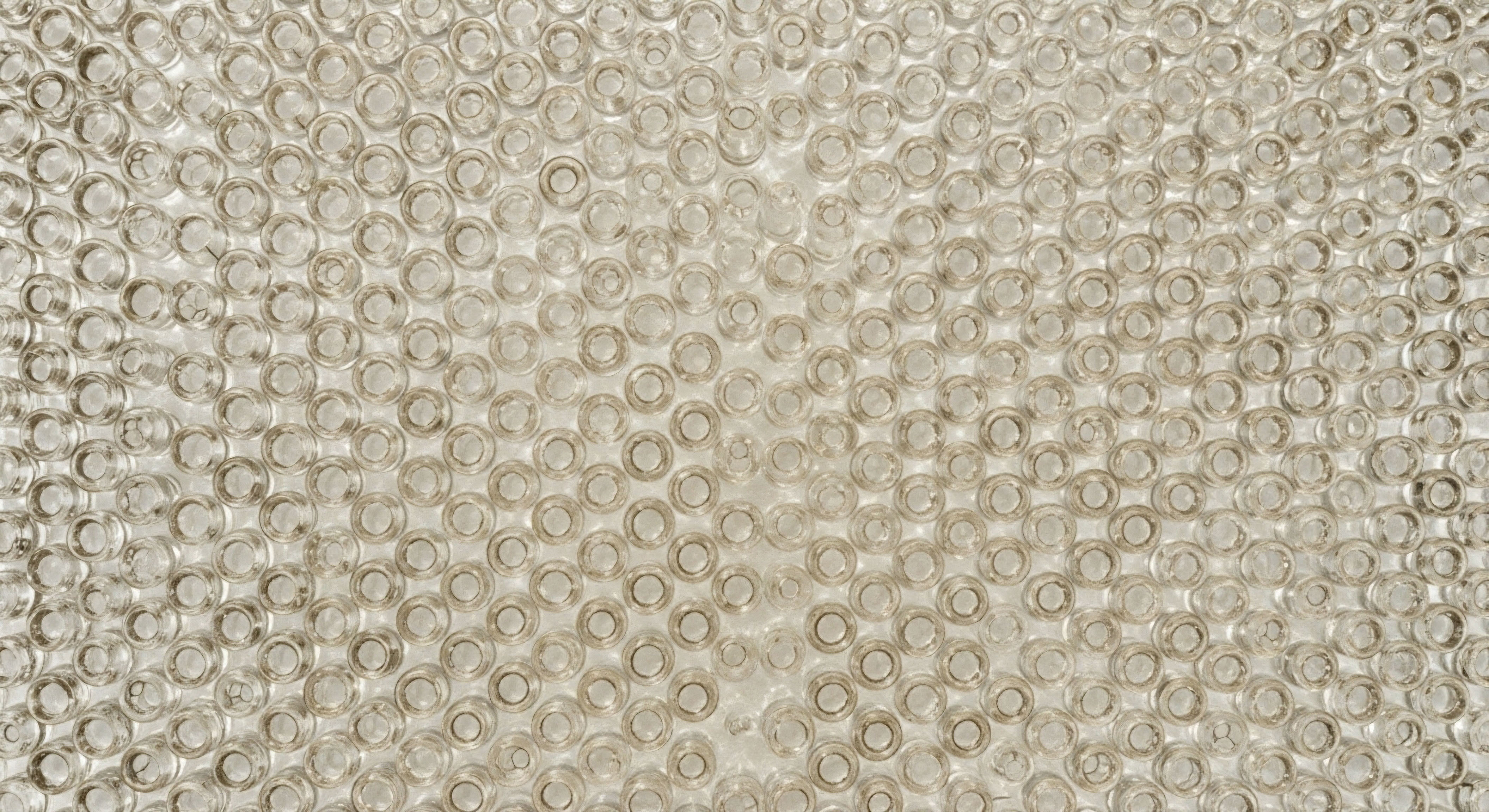

Fundamentals
You may feel a persistent sense of fatigue that sleep does not resolve, or a subtle but unshakeable shift in your mood and mental clarity. These experiences are valid and deeply personal, and they often point toward the intricate communication network within your body known as the endocrine system.
This system relies on chemical messengers, or hormones, to orchestrate everything from your energy levels and metabolic rate to your stress response and reproductive health. Understanding the raw materials that build this system is the first step toward reclaiming your vitality. Specific dietary fats are the foundational building blocks for your most influential steroid hormones, including testosterone, estrogens, and cortisol.
The body does not create these hormones from nothing. It requires a specific starting molecule, cholesterol, which is a lipid, or fat, that you obtain from your diet and that your liver also produces. Think of your hormonal production centers, like the adrenal glands and gonads, as highly specialized factories.
These factories receive shipments of cholesterol and, through a series of precise biochemical steps, convert that raw material into the finished hormonal products your body needs to function. The quality and availability of these foundational fats have a direct bearing on the factory’s ability to meet production demands. A diet deficient in healthy fats can limit the supply of necessary precursors, potentially leading to suboptimal hormonal output and the very symptoms you may be experiencing.
The consumption of dietary fats provides the essential cholesterol backbone required for the synthesis of all steroid hormones.

How Do Dietary Fats Build My Hormones?
The process of converting cholesterol into steroid hormones is a sophisticated biological sequence called steroidogenesis. This is a cascade of enzymatic reactions where one hormone is converted into the next in a specific line of production. It begins with cholesterol and branches out to create progesterone, cortisol, DHEA, testosterone, and the various forms of estrogen.
Each step is controlled by a specific enzyme, and the entire process is regulated by signaling hormones from the brain, primarily from the pituitary gland. When you consume dietary fats, you are supplying the fundamental substrate that initiates this entire cascade. Without an adequate supply of cholesterol, the production line for every single steroid hormone is compromised from the start.
Different types of dietary fats also contribute to the overall health of the cells that produce and respond to hormones. Cell membranes, the outer layer of every cell in your body, are composed of a lipid bilayer. The fluidity and integrity of these membranes depend on the types of fatty acids incorporated into them.
A fluid and healthy membrane ensures that hormone receptors, which are proteins embedded within that membrane, can function correctly. This allows cells to receive hormonal signals efficiently. Therefore, dietary fats contribute to both the creation of the hormonal message and the ability of your cells to hear that message clearly.

The Architecture of Hormonal Health
Your body’s hormonal architecture is built upon the fats you consume. Saturated fats, often found in animal products and tropical oils, provide a stable source of cholesterol for hormone production. Monounsaturated fats, abundant in olive oil, avocados, and certain nuts, contribute to healthy cell membranes and possess anti-inflammatory properties.
Polyunsaturated fats, which include the omega-3 and omega-6 families, are unique. They are precursors to signaling molecules that regulate inflammation throughout the body, a process that has a profound effect on endocrine function. An imbalance in these fats can lead to a state of chronic, low-grade inflammation, which can disrupt hormone production, transport, and receptor function.
This is why a personalized approach to nutrition is so valuable. The goal is to provide your body with the precise combination of fatty acids it needs to support its unique biochemical requirements. For men experiencing symptoms of low testosterone, ensuring adequate intake of healthy saturated and monounsaturated fats can support the body’s natural production pathways.
For women navigating the hormonal fluctuations of perimenopause, a diet rich in omega-3 fatty acids can help modulate inflammation and support the production of progesterone and estrogen. The journey to hormonal balance begins with a deep appreciation for the foundational role of these essential nutrients.


Intermediate
Moving beyond the foundational concept of fats as mere building blocks, we can examine their more active roles in modulating hormonal bioavailability. Bioavailability refers to the amount of a hormone that is active and able to exert its effects on a target cell.
A blood test might show a certain level of total testosterone, for instance, but only a small fraction of that total is “free” or unbound and thus biologically active. Dietary fats influence this dynamic in several ways, primarily through their impact on transport proteins, cell membrane composition, and the inflammatory environment of the body.
One of the key regulators of sex hormone bioavailability is Sex Hormone-Binding Globulin (SHBG), a protein produced by the liver that binds to testosterone and estrogen in the bloodstream. When a hormone is bound to SHBG, it is inactive.
The concentration of SHBG in the blood is therefore a determinant of how much free hormone is available to your tissues. Research indicates that dietary fat composition can influence SHBG levels. For example, diets higher in healthy fats, particularly those rich in omega-3 fatty acids, have been associated with lower SHBG levels in some contexts. This would translate to a higher percentage of free, bioavailable testosterone and estrogen, enhancing the efficiency of the hormones your body is already producing.
The types of fats in your diet can directly influence the levels of transport proteins like SHBG, thereby regulating the amount of active hormone available to your cells.

Can the Fats I Eat Affect How My Hormones Are Transported?
Yes, the fats you consume can modulate the intricate system of hormone transport and delivery. The composition of your diet sends signals to the liver, which is the primary site of synthesis for binding globulins like SHBG. A diet that promotes a healthy inflammatory response and supports liver function can help maintain SHBG in an optimal range.
Polyunsaturated fats, especially the omega-3s found in fatty fish like salmon and sardines, are converted into signaling molecules called resolvins and protectins. These molecules actively resolve inflammation, which can in turn downregulate the liver’s production of SHBG. Conversely, a diet high in processed fats and refined carbohydrates can promote insulin resistance, a condition known to alter SHBG levels and disrupt hormonal balance.
Furthermore, the fatty acids from your diet are incorporated directly into the membranes of your cells. This includes the membranes of your red blood cells, which transport oxygen, and the endothelial cells that line your blood vessels. The fluidity of these membranes, determined by the ratio of saturated to unsaturated fats, affects how hormones travel through the bloodstream and pass into tissues.
A rigid, inflexible cell membrane can impair the ability of hormones to reach their target receptors, even if levels of free hormone are adequate. This illustrates a deeper principle ∞ hormonal health is a function of the entire biological system, from the initial synthesis of the hormone to its final interaction with a cell receptor.

Comparing Dietary Fat Families
To understand their distinct roles, it is useful to categorize dietary fats and examine their primary physiological impacts. Each family of fats has a unique chemical structure that dictates how it is used by the body, from energy storage and membrane structure to the generation of potent signaling molecules.
| Fatty Acid Type | Primary Dietary Sources | Key Biological Roles in Hormonal Health |
|---|---|---|
| Saturated Fatty Acids (SFA) | Coconut oil, butter, red meat, full-fat dairy | Provide cholesterol for steroid hormone synthesis; contribute to cell membrane structure. |
| Monounsaturated Fatty Acids (MUFA) | Olive oil, avocados, almonds, macadamia nuts | Improve cell membrane fluidity; support insulin sensitivity; possess anti-inflammatory properties. |
| Omega-6 Polyunsaturated (PUFA) | Soybean oil, corn oil, sunflower seeds, walnuts | Precursor to generally pro-inflammatory eicosanoids (prostaglandins, leukotrienes). |
| Omega-3 Polyunsaturated (PUFA) | Fatty fish (salmon, mackerel), flaxseeds, chia seeds, walnuts | Precursor to anti-inflammatory eicosanoids; can lower SHBG; supports brain and nerve health. |

Fats and the Inflammatory Cascade
The balance between omega-6 and omega-3 polyunsaturated fats is a critical factor in regulating systemic inflammation. Both types of fat compete for the same enzymes (desaturases and elongases) to be converted into eicosanoids. Omega-6 fatty acids are typically converted into arachidonic acid (AA), the precursor to largely pro-inflammatory molecules.
Omega-3 fatty acids, like EPA and DHA, are converted into molecules that are anti-inflammatory or are involved in resolving inflammation. A typical Western diet often has a ratio of omega-6 to omega-3 that is heavily skewed towards the former, sometimes as high as 20:1. This creates a biochemical environment that favors a chronic, low-grade inflammatory state.
This persistent inflammation can directly impair endocrine function. It can interfere with the signaling between the pituitary gland and the gonads (the HPG axis), reduce the sensitivity of hormone receptors on cells, and contribute to conditions like insulin resistance, which is deeply intertwined with hormonal dysregulation like Polycystic Ovary Syndrome (PCOS) in women and low testosterone in men.
By intentionally increasing the intake of omega-3-rich foods and reducing the consumption of processed omega-6-heavy vegetable oils, one can shift this balance. This dietary modification can improve hormonal bioavailability by quieting the inflammatory noise that interferes with clear hormonal communication.
- Testosterone Optimization Protocols ∞ For men on TRT, a diet rich in MUFAs and omega-3s can enhance the effectiveness of the therapy by improving insulin sensitivity and lowering SHBG, allowing for greater bioactivity of the administered testosterone.
- Female Hormone Balance ∞ For women, particularly those in perimenopause, omega-3 fatty acids can help manage inflammatory symptoms and support progesterone production. The docosapentaenoic acid (DPA), an omega-3, has been linked to a reduced risk of anovulation.
- Growth Hormone Peptide Therapy ∞ The effectiveness of peptides like Sermorelin or Ipamorelin, which stimulate the body’s own growth hormone production, is enhanced in a low-inflammation environment. Healthy fats support the cellular health and signaling required for an optimal response to these therapies.


Academic
A sophisticated analysis of hormonal bioavailability requires an examination of the cellular and molecular mechanisms that govern hormone-receptor interactions. Dietary lipids are integral to these processes, extending their influence deep into the subcellular architecture of target tissues. The composition of the plasma membrane, specifically the organization of microdomains known as lipid rafts, is a determinant of endocrine signaling efficiency.
These rafts are dynamic assemblies of cholesterol and sphingolipids that function as organizing platforms for signaling molecules, including G-protein coupled receptors and receptor tyrosine kinases, through which many peptide and steroid hormones exert their effects.
The fatty acid composition of membrane phospholipids, which is directly influenced by dietary intake, dictates the biophysical properties of the membrane, including its fluidity and the propensity for lipid raft formation. Diets rich in omega-3 polyunsaturated fatty acids, such as eicosapentaenoic acid (EPA) and docosahexaenoic acid (DHA), can alter the lipid composition of these rafts, displacing arachidonic acid and modifying the localization and dimerization of hormone receptors.
This can change the downstream signaling cascade initiated by hormone binding. For example, altering the lipid environment of the insulin receptor can enhance its phosphorylation and subsequent activation, improving insulin sensitivity. This same principle applies to receptors for gonadotropins and other hormones central to the clinical protocols of hormonal optimization.
The specific fatty acid profile of a cell’s membrane directly modulates the function of hormone receptors embedded within it.

What Is the Role of Cell Membranes in Hormone Signaling?
The cell membrane is the interface between the extracellular environment and the cell’s internal machinery. For a hormone to be bioavailable in a meaningful sense, it must successfully bind its receptor and initiate a signal. The membrane’s lipid composition is a primary determinant of this success.
For steroid hormones like testosterone and estradiol, which are lipid-soluble, the ability to traverse the membrane and bind to intracellular receptors is also influenced by the membrane’s physical properties. A membrane with a high degree of fluidity, promoted by a higher proportion of unsaturated fatty acids, can facilitate this transit.
Furthermore, the conversion of some hormones occurs at the cellular level. For instance, the enzyme 5-alpha reductase, which converts testosterone to the more potent androgen dihydrotestosterone (DHT), is a membrane-bound enzyme. Its activity can be modulated by the surrounding lipid environment.
Similarly, aromatase, the enzyme that converts testosterone to estradiol, is also influenced by the cellular milieu. The fatty acid profile of a tissue can therefore influence the local hormonal environment, determining the relative concentrations of different active metabolites. This localized, intracrine regulation is a frontier of endocrinology and highlights the profound influence of dietary fats on hormone action at the tissue-specific level.

Eicosanoid Pathways and Endocrine Regulation
The competition between omega-6 and omega-3 fatty acids for the cyclooxygenase (COX) and lipoxygenase (LOX) enzymes is a central mechanism through which diet modulates the endocrine system. The products of these pathways, eicosanoids, are potent, short-lived signaling molecules that regulate inflammation, blood flow, and platelet aggregation. Their balance is a key factor in overall systemic health.
| Parent Fatty Acid | Key Eicosanoid Products | General Endocrine & Inflammatory Effect |
|---|---|---|
| Omega-6 (Arachidonic Acid) | Prostaglandin E2 (PGE2), Leukotriene B4 (LTB4) | Largely pro-inflammatory; can increase inflammatory signaling that disrupts HPG axis function. |
| Omega-3 (Eicosapentaenoic Acid) | Prostaglandin E3 (PGE3), Leukotriene B5 (LTB5) | Weakly inflammatory or anti-inflammatory; competes with arachidonic acid. |
| Omega-3 (Docosahexaenoic Acid) | Resolvins, Protectins, Maresins | Actively pro-resolving; shuts down inflammatory processes and promotes tissue healing. |

Steroidogenesis and Fatty Acid Substrates
The very first step of steroidogenesis is the transport of cholesterol from the outer mitochondrial membrane to the inner mitochondrial membrane, a process mediated by the Steroidogenic Acute Regulatory (StAR) protein. The activity of StAR is a rate-limiting step for the entire steroidogenic cascade.
This process is highly sensitive to the cellular redox state and inflammatory signaling, both of which are influenced by dietary fat intake. Chronic inflammation, driven by an excess of omega-6 derived eicosanoids, can impair StAR protein expression and function, thereby reducing the foundational capacity for hormone production.
Moreover, fatty acids themselves can act as signaling molecules within steroidogenic cells. They can activate nuclear receptors like Peroxisome Proliferator-Activated Receptors (PPARs), which in turn regulate the expression of genes involved in lipid metabolism and steroidogenesis.
For example, activation of PPAR-alpha by certain fatty acids can enhance the expression of genes involved in cholesterol uptake and transport in the testes and ovaries. This provides a direct link between the types of fats consumed and the genetic machinery responsible for producing hormones.
Studies in regularly menstruating women have shown associations between higher total fat intake, particularly PUFAs, and small increases in total and free testosterone concentrations, suggesting a direct impact on steroidogenesis or bioavailability. The intake of specific long-chain omega-3s was also associated with increased progesterone and a lower risk of anovulation, pointing to a supportive role in reproductive function.
This level of mechanistic detail informs the clinical application of hormonal therapies. For a patient undergoing Testosterone Replacement Therapy, optimizing their dietary fat profile to favor omega-3s and monounsaturated fats can create a biological environment that maximizes the therapeutic benefit. It can lower systemic inflammation, potentially reduce SHBG, and enhance the sensitivity of androgen receptors in target tissues like muscle and bone. The diet becomes an adjunct therapy, working synergistically with the protocol to restore function and vitality.
- Cholesterol Transport ∞ The process begins with the delivery of cholesterol to the mitochondria of steroidogenic cells. The efficiency of this step is influenced by the overall lipid metabolism of the cell.
- StAR Protein Activation ∞ The StAR protein facilitates the movement of cholesterol across the mitochondrial membrane, which is the rate-limiting step in hormone production.
- Enzymatic Conversion ∞ A cascade of enzymes, primarily from the cytochrome P450 family, sequentially modify the cholesterol molecule to produce progesterone, androgens, and estrogens. The function of these membrane-bound enzymes is sensitive to the surrounding lipid environment.

References
- Mumford, S. L. Chavarro, J. E. Zhang, C. Perkins, N. J. Sjaarda, L. A. Pollack, A. Z. Schliep, K.C. Michels, K. A. Zarek, S. M. Plowden, T. C. Radin, R. G. Messer, L. C. Frankel, R. A. & Wactawski-Wende, J. (2016). Dietary fat intake and reproductive hormone concentrations and ovulation in regularly menstruating women. The American Journal of Clinical Nutrition, 103 (3), 868 ∞ 877.
- Whigham, L. D. Butz, D. E. Das, V. Cook, M. E. & Abbott, D. H. (2012). Hormonal and metabolic effects of polyunsaturated fatty acids in young women with polycystic ovary syndrome ∞ results from a cross-sectional analysis and a randomized, placebo-controlled, crossover trial. The American Journal of Clinical Nutrition, 95 (5), 1237 ∞ 1245.
- Simopoulos, A. P. (2002). The importance of the ratio of omega-6/omega-3 essential fatty acids. Biomedicine & Pharmacotherapy, 56 (8), 365-379.
- Carrillo, C. Cavia, M. M. & Alonso-Torre, S. (2012). Role of olive oil in the prevention of lipid oxidative damage in vascular wall. Public Health Nutrition, 15 (10), 1911-1918.
- Attia, P. (2022). Outlive ∞ The Science and Art of Longevity. Harmony Books.
- Gottfried, S. (2013). The Hormone Cure ∞ Reclaim Balance, Sleep, Sex Drive, and Vitality Naturally with the Gottfried Protocol. Scribner.
- Hyman, M. (2012). The Blood Sugar Solution ∞ The Ultra-Healthy Program for Losing Weight, Preventing Disease, and Feeling Great Now!. Little, Brown and Company.
- Guyton, A.C. & Hall, J.E. (2020). Guyton and Hall Textbook of Medical Physiology. Elsevier.
- Boron, W.F. & Boulpaep, E.L. (2016). Medical Physiology. Elsevier.
- Stocco, D. M. (2001). StAR protein and the regulation of steroid hormone biosynthesis. Annual Review of Physiology, 63, 193-213.

Reflection

Charting Your Personal Biological Map
The information presented here provides a detailed map of the biochemical pathways connecting what you eat to how you feel. It demonstrates that the fats in your diet are active participants in your body’s endocrine symphony. This knowledge moves you from a passive observer of your symptoms to an active participant in your own wellness.
You now possess a deeper understanding of the biological logic behind personalized nutrition. The sensations you experience in your body are real, and they are connected to these intricate systems.
This understanding is the starting point. The next step on your path involves looking at your own life, your own diet, and your own health goals. How does this information apply to your personal context? What small, sustainable changes can you make to begin shifting your dietary fat profile in a direction that supports your hormonal health?
The journey to reclaiming your vitality is a process of continuous learning and self-discovery, grounded in a solid foundation of scientific understanding. Your biology is unique, and the path to optimizing it will be equally personal, requiring thoughtful consideration and expert guidance to translate this knowledge into a tangible, effective protocol.

Glossary

steroid hormones

dietary fats

steroidogenesis

fatty acids

hormone receptors

hormone production

signaling molecules that regulate inflammation

omega-3 fatty acids

perimenopause

hormonal bioavailability

cell membrane

sex hormone-binding globulin

shbg

dietary fat

signaling molecules

hormonal health

arachidonic acid

eicosanoids

hpg axis

insulin sensitivity

lipid rafts

molecules that regulate inflammation

star protein




